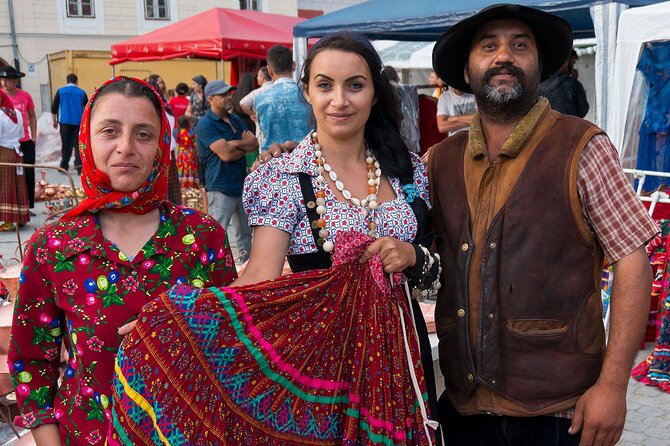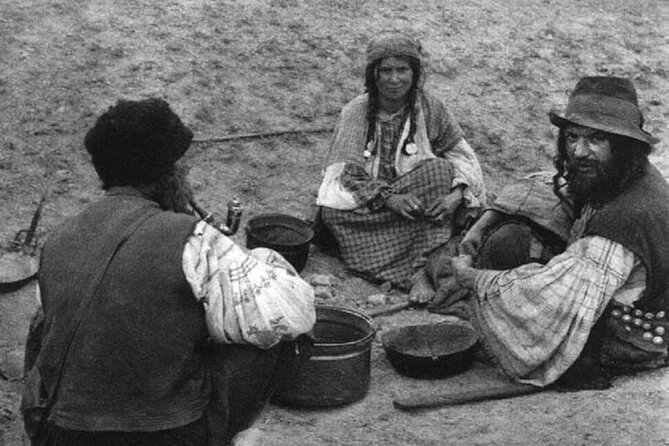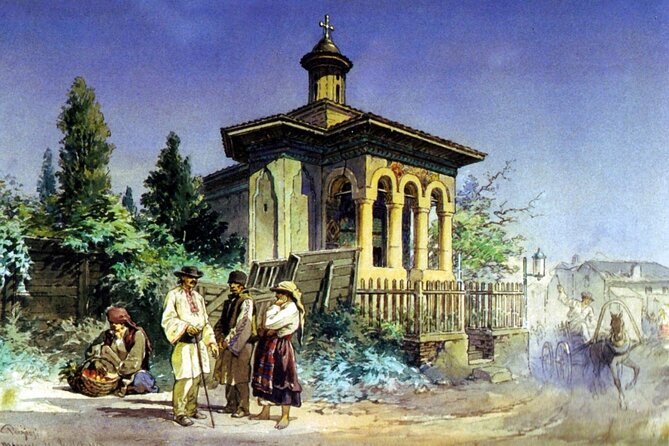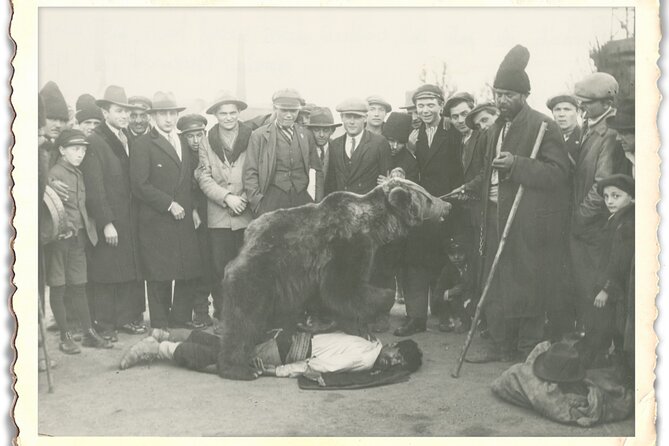Exploring the lesser-known history of Gypsy enslavement in Romania unveils a narrative of profound suffering and resilience. The shadows of ‘Robe‘ cast a long and complex legacy that continues to shape the Roma community’s struggles today. Understanding the depths of this historical injustice provides a critical lens through which to comprehend the challenges faced by the Roma population in contemporary Romania. As the layers of this narrative are peeled back, a more nuanced understanding emerges, shedding light on the enduring impact of past atrocities on present-day realities.
Good To Know

- Roma endured ‘Robe’ enslavement in Romania from 14th to 19th centuries.
- Owned by nobility, Roma faced severe restrictions and inhumane conditions.
- Enslavement led to lasting impacts on the Roma population.
- Violence, discrimination, and limited freedoms marked this dark period.
- Understanding this legacy is crucial to addressing modern Roma challenges.
Historical Background
Throughout history, the story of the Gypsies has been shrouded in mystery and misconception, making it a fascinating tale to explore.
The historical background of the Gypsies is a complex tapestry woven with threads of migration, persecution, and resilience. Originating from the Indian subcontinent, the Gypsies embarked on a journey that led them across continents, facing discrimination and marginalization along the way.
In Romania, the Gypsies, also known as Roma, have a long history intertwined with slavery, where they were bought and sold until the mid-19th century. This dark chapter in their past has left lasting scars on the Roma community, shaping their cultural identity and struggles for equality.
Understanding this historical context is crucial in unraveling the truth behind the Gypsy narrative.
Find more activities and experiences we've covered in Bucharest.
Origins and Migration

Embarking on a journey from the Indian subcontinent, the Gypsies traversed continents, facing discrimination and resilience along the way. This nomadic group, believed to have originated from regions in Northern India, began their migration around the 11th century, spreading across Europe and beyond. The Gypsies, also known as Roma or Romani people, carried with them a rich cultural heritage that blended with influences from the lands they traveled through. Here is a glimpse into their fascinating journey:
| Origin | Migration Route |
|---|---|
| India | Persia, Byzantine Empire |
| Eastern Europe | |
| Western Europe |
Social Status and Discrimination

Navigating through centuries of history, the Gypsies have encountered a complex tapestry of social status and discrimination across various lands. From being labeled as social outcasts to facing systemic discrimination, the Roma people have often been marginalized and stereotyped.
In many societies, they’ve struggled to access equal opportunities in education, employment, and healthcare. Stereotypes depicting them as thieves or beggars have perpetuated negative perceptions, leading to exclusion and mistreatment. Despite efforts to combat discrimination, the Roma community continues to face challenges in achieving full social acceptance and equality.
It’s essential to acknowledge these injustices and work towards creating a more inclusive and respectful society for all individuals, regardless of their cultural background.
Gypsy Enslavement in Romania

Unveiling a harrowing chapter in Romanian history, the enslavement of the Gypsy community reveals a dark reality of oppression and exploitation. From the 14th to the 19th centuries, Roma people in Romania endured enslavement, known as ‘Robe.’ They were owned by Romanian nobility, forced into labor, and subjected to inhumane conditions.
The enslavement of the Roma community persisted for centuries, with many facing violence, discrimination, and severe restrictions on their freedom. This dark period in Romanian history left a lasting impact on the Roma population, shaping their social status and relationships within society.
Understanding the legacy of Gypsy enslavement is crucial to comprehending the challenges faced by the Roma community in modern-day Romania.
Modern-Day Challenges
Facing a myriad of societal barriers and persistent stereotypes, the Roma community in modern-day Romania continues to confront significant challenges in their daily lives. From widespread discrimination in education and employment to inadequate access to healthcare and housing, Roma individuals often find themselves marginalized and disadvantaged.
Economic hardships further exacerbate their situation, with many Roma families living below the poverty line. Plus, the lack of political representation and the perpetuation of negative stereotypes in media and society hinder their efforts to break free from these challenges.
Despite these obstacles, grassroots organizations and advocates within the Roma community are working tirelessly to promote awareness, combat discrimination, and improve the overall quality of life for Roma individuals in Romania.
Cultural Contributions

Amidst the challenges faced by the Roma community in Romania, their cultural contributions shine brightly, showcasing a rich heritage of art, music, and craftsmanship.
The Roma people, often known for their vibrant music, have made significant impacts on various artistic fields. From traditional folk music to modern interpretations, their melodies resonate with passion and history.
Plus, Roma artisans are renowned for their exquisite craftsmanship, creating intricate jewelry, colorful textiles, and detailed woodwork.
This cultural richness isn’t only a source of pride for the Roma community but also serves as a bridge for cultural exchange and understanding.
Legal Recognition and Activism
Legal recognition and activism play pivotal roles in advancing the rights and empowerment of the Roma community in Romania. Through legal channels and grassroots movements, progress is being made to combat discrimination and improve the socio-economic conditions of the Roma people.
| Initiative | Impact |
|---|---|
| Legal Aid Clinics | Provide legal assistance and representation for Roma facing discrimination. |
| Advocacy Campaigns | Raise awareness and lobby for policy changes to protect Roma rights. |
| Educational Workshops | Empower Roma individuals with knowledge of their rights and how to access resources. |
| Community Organizing Efforts | Unite Roma communities to amplify their voices and demand equal treatment. |
The Path to Empowerment

Embarking on the journey towards empowerment, Roma individuals in Romania are forging pathways to self-determination and societal change. Through initiatives focused on education, entrepreneurship, and cultural preservation, Roma communities are reclaiming their narratives and challenging stereotypes.
Organizations like Romani CRISS are providing support for Roma rights advocacy, while projects such as Romani Design are showcasing the talents of Roma artisans. By fostering a sense of pride in their heritage and skills, Roma individuals are breaking barriers and reshaping their futures.
Empowerment for the Roma in Romania isn’t just about individual success but about creating a more inclusive society where their voices are heard and their contributions valued. As they continue on this journey, Roma empowerment becomes a beacon of hope for marginalized communities striving for equality and respect.
Frequently Asked Questions
How Does the Traditional Roma Craft Preserve Cultural Heritage?
Preserving cultural heritage, traditional Roma crafts showcase generations of skill and artistry. By passing down techniques and designs, these artisans keep their rich heritage alive, connecting past and present in each unique creation.
What Are Some Common Misconceptions About the Roma Community?
Many common misconceptions about the Roma community include stereotypes of criminality, laziness, and nomadism. These harmful beliefs overlook the rich cultural heritage, resilience, and diversity within the Roma population, perpetuating discrimination and marginalization.
How Can Travelers Support Roma Empowerment Through Tourism?
Travelers can support Roma empowerment through tourism by booking experiences that directly benefit Roma communities. By participating in tours led by Roma guides or purchasing goods made by Roma craftsmen, visitors contribute to economic empowerment and cultural understanding.
What Initiatives Are in Place to Combat Discrimination Against Roma?
Initiatives like educational programs, job training, and legal advocacy work to combat discrimination against Roma. They aim to promote equality and empower the community. Through awareness and support, positive change can be achieved for Roma inclusion.
What Opportunities Exist for Roma Artisans to Showcase Their Work Internationally?
Roma artisans have various opportunities to showcase their work internationally through cultural events, craft fairs, and online platforms. These avenues not only promote their talents but also help in preserving traditional Roma craftsmanship for future generations.
The Sum Up
To sum it up, the history of Roma enslavement in Romania sheds light on the struggles and resilience of the community. Despite facing discrimination and social barriers, the Roma people have made significant cultural contributions and continue to fight for equality.
By understanding and acknowledging this dark chapter in history, we can work towards empowering the Roma population and creating a more inclusive society for all.
Let’s stand together in solidarity and support the Roma community in their quest for justice and recognition.
More Tour Reviews in Bucharest
- Day Trip Bucharest to Slanic Prahova Salt Mine Minivan of 8
- From Bucharest: Veliko Tarnovo and Arbanassi Day Trip
- From Bucharest: 14-Day Tour Romania, Serbia, and Bulgaria
- From Bucharest: Bulgaria & Veliko Tarnovo – Private Tour
- Bucharest Self Guided Tour from Dictator to Dracula
- Bucharest Express – Private City Tour by Car
Looking for something different? Other Bucharest activities we've written about
- Day Trip Bucharest to Slanic Prahova Salt Mine Minivan of 8
- From Bucharest: Veliko Tarnovo and Arbanassi Day Trip
- From Bucharest: 14-Day Tour Romania, Serbia, and Bulgaria
- From Bucharest: Bulgaria & Veliko Tarnovo – Private Tour
- Bucharest Self Guided Tour from Dictator to Dracula
- Bucharest Express – Private City Tour by Car
- 2 Days Private Tour from Bucharest to Black See and Danube Delta
- Bears and Dracula Private Full-Day Tour from Bucharest
- E Bike Rental in Bucharest
- Constanta and the Black Sea Private Tour from Bucharest
- Muddy Volcanoes and Largest Salt Mine-Private Tour from Bucharest
- Dracula’s Castle with Peles Castle and Brasov Day Trip
